International Business: Cultural Dimensions and Management Practices
VerifiedAdded on 2020/04/29
|13
|3711
|81
Report
AI Summary
This report provides a comprehensive analysis of international business, focusing on cultural dimensions, management practices, and change management strategies. It begins by examining Hofstede's and Trompenaars' models of cultural differences, highlighting their strengths and limitations in understanding national cultures. The report then delves into key management practices, including employee motivation, leadership, and teamwork, emphasizing their importance in contemporary business organizations. It also addresses conflict resolution and ethical issues within a global context. The case study explores cultural differences between Australian and French nationals, applying Hofstede's model to analyze their differing management approaches. Finally, the report discusses change management models, such as Lewin's and Kotter's, and their application in multinational organizations, such as Port Phillip Pharmaceuticals. The report considers the challenges of language barriers and the need for adaptive leadership styles in diverse international settings. This report is contributed by a student and published on Desklib, a platform providing AI-based study tools for students.
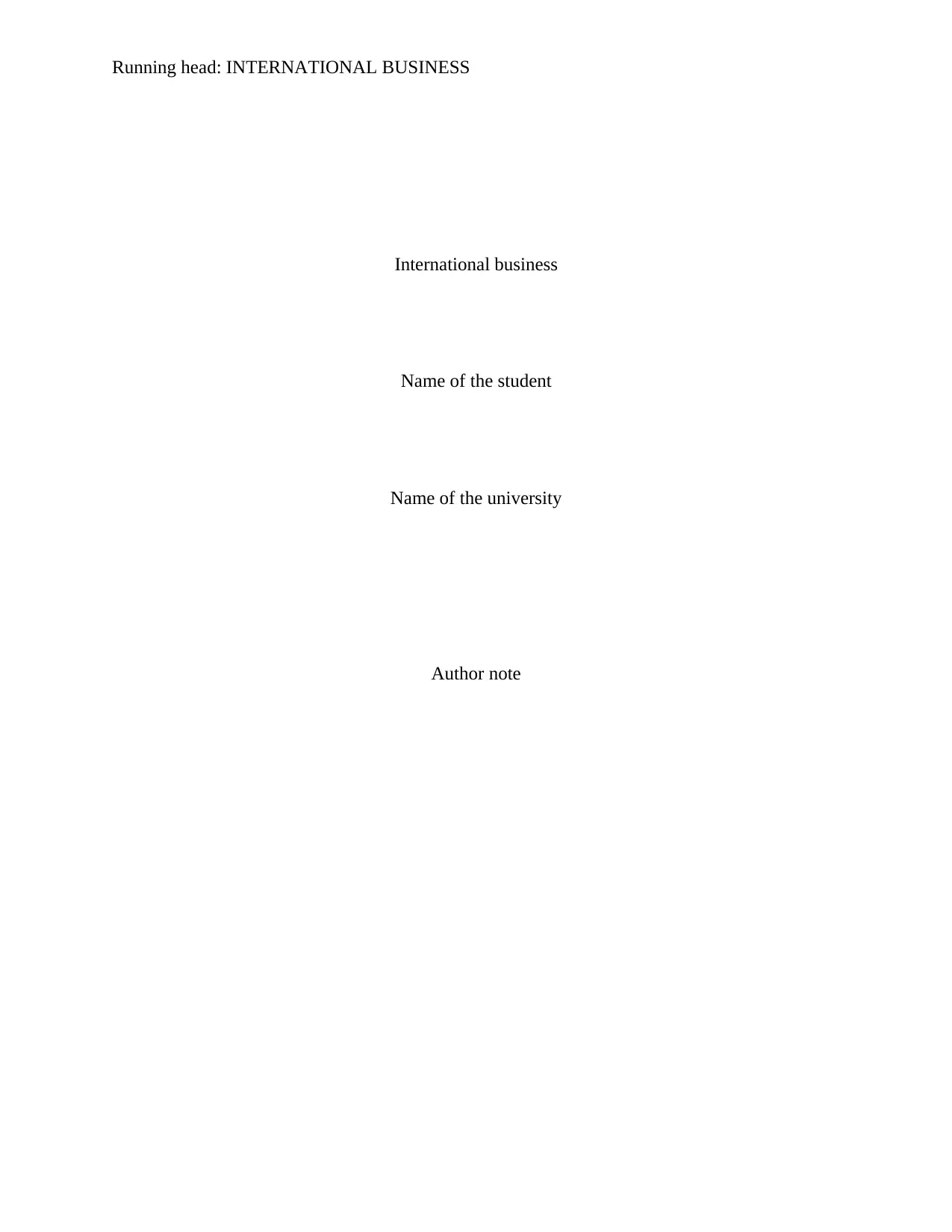
Running head: INTERNATIONAL BUSINESS
International business
Name of the student
Name of the university
Author note
International business
Name of the student
Name of the university
Author note
Paraphrase This Document
Need a fresh take? Get an instant paraphrase of this document with our AI Paraphraser
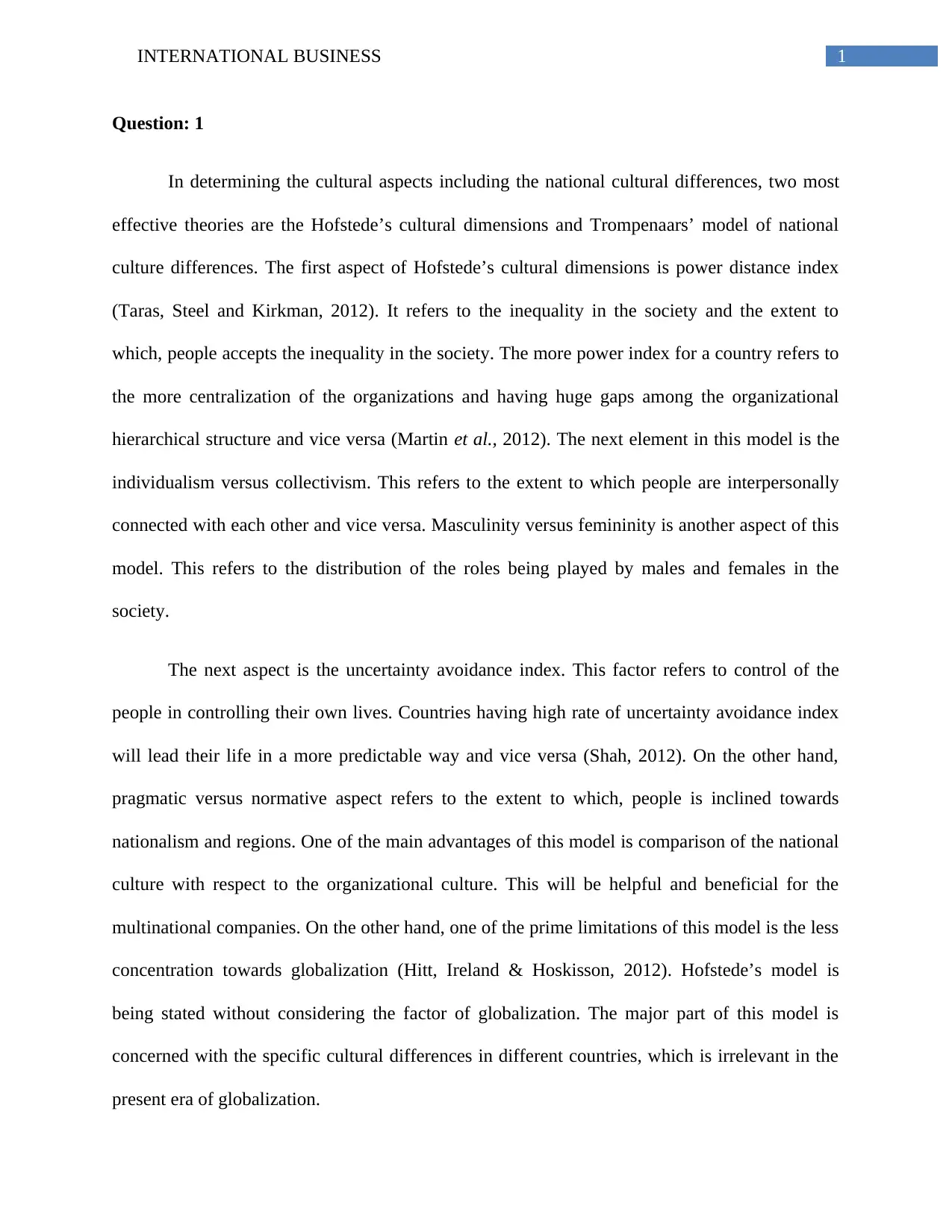
1INTERNATIONAL BUSINESS
Question: 1
In determining the cultural aspects including the national cultural differences, two most
effective theories are the Hofstede’s cultural dimensions and Trompenaars’ model of national
culture differences. The first aspect of Hofstede’s cultural dimensions is power distance index
(Taras, Steel and Kirkman, 2012). It refers to the inequality in the society and the extent to
which, people accepts the inequality in the society. The more power index for a country refers to
the more centralization of the organizations and having huge gaps among the organizational
hierarchical structure and vice versa (Martin et al., 2012). The next element in this model is the
individualism versus collectivism. This refers to the extent to which people are interpersonally
connected with each other and vice versa. Masculinity versus femininity is another aspect of this
model. This refers to the distribution of the roles being played by males and females in the
society.
The next aspect is the uncertainty avoidance index. This factor refers to control of the
people in controlling their own lives. Countries having high rate of uncertainty avoidance index
will lead their life in a more predictable way and vice versa (Shah, 2012). On the other hand,
pragmatic versus normative aspect refers to the extent to which, people is inclined towards
nationalism and regions. One of the main advantages of this model is comparison of the national
culture with respect to the organizational culture. This will be helpful and beneficial for the
multinational companies. On the other hand, one of the prime limitations of this model is the less
concentration towards globalization (Hitt, Ireland & Hoskisson, 2012). Hofstede’s model is
being stated without considering the factor of globalization. The major part of this model is
concerned with the specific cultural differences in different countries, which is irrelevant in the
present era of globalization.
Question: 1
In determining the cultural aspects including the national cultural differences, two most
effective theories are the Hofstede’s cultural dimensions and Trompenaars’ model of national
culture differences. The first aspect of Hofstede’s cultural dimensions is power distance index
(Taras, Steel and Kirkman, 2012). It refers to the inequality in the society and the extent to
which, people accepts the inequality in the society. The more power index for a country refers to
the more centralization of the organizations and having huge gaps among the organizational
hierarchical structure and vice versa (Martin et al., 2012). The next element in this model is the
individualism versus collectivism. This refers to the extent to which people are interpersonally
connected with each other and vice versa. Masculinity versus femininity is another aspect of this
model. This refers to the distribution of the roles being played by males and females in the
society.
The next aspect is the uncertainty avoidance index. This factor refers to control of the
people in controlling their own lives. Countries having high rate of uncertainty avoidance index
will lead their life in a more predictable way and vice versa (Shah, 2012). On the other hand,
pragmatic versus normative aspect refers to the extent to which, people is inclined towards
nationalism and regions. One of the main advantages of this model is comparison of the national
culture with respect to the organizational culture. This will be helpful and beneficial for the
multinational companies. On the other hand, one of the prime limitations of this model is the less
concentration towards globalization (Hitt, Ireland & Hoskisson, 2012). Hofstede’s model is
being stated without considering the factor of globalization. The major part of this model is
concerned with the specific cultural differences in different countries, which is irrelevant in the
present era of globalization.
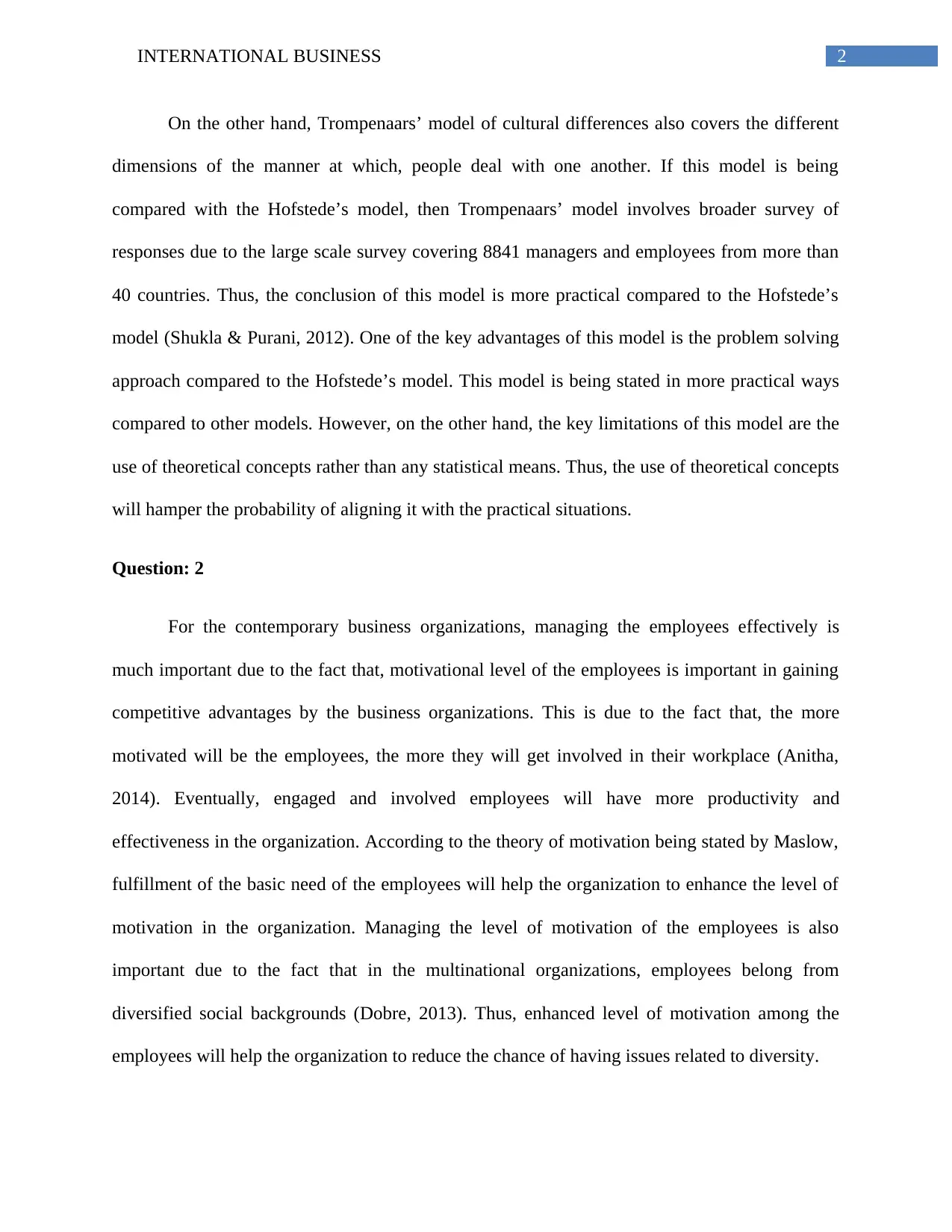
2INTERNATIONAL BUSINESS
On the other hand, Trompenaars’ model of cultural differences also covers the different
dimensions of the manner at which, people deal with one another. If this model is being
compared with the Hofstede’s model, then Trompenaars’ model involves broader survey of
responses due to the large scale survey covering 8841 managers and employees from more than
40 countries. Thus, the conclusion of this model is more practical compared to the Hofstede’s
model (Shukla & Purani, 2012). One of the key advantages of this model is the problem solving
approach compared to the Hofstede’s model. This model is being stated in more practical ways
compared to other models. However, on the other hand, the key limitations of this model are the
use of theoretical concepts rather than any statistical means. Thus, the use of theoretical concepts
will hamper the probability of aligning it with the practical situations.
Question: 2
For the contemporary business organizations, managing the employees effectively is
much important due to the fact that, motivational level of the employees is important in gaining
competitive advantages by the business organizations. This is due to the fact that, the more
motivated will be the employees, the more they will get involved in their workplace (Anitha,
2014). Eventually, engaged and involved employees will have more productivity and
effectiveness in the organization. According to the theory of motivation being stated by Maslow,
fulfillment of the basic need of the employees will help the organization to enhance the level of
motivation in the organization. Managing the level of motivation of the employees is also
important due to the fact that in the multinational organizations, employees belong from
diversified social backgrounds (Dobre, 2013). Thus, enhanced level of motivation among the
employees will help the organization to reduce the chance of having issues related to diversity.
On the other hand, Trompenaars’ model of cultural differences also covers the different
dimensions of the manner at which, people deal with one another. If this model is being
compared with the Hofstede’s model, then Trompenaars’ model involves broader survey of
responses due to the large scale survey covering 8841 managers and employees from more than
40 countries. Thus, the conclusion of this model is more practical compared to the Hofstede’s
model (Shukla & Purani, 2012). One of the key advantages of this model is the problem solving
approach compared to the Hofstede’s model. This model is being stated in more practical ways
compared to other models. However, on the other hand, the key limitations of this model are the
use of theoretical concepts rather than any statistical means. Thus, the use of theoretical concepts
will hamper the probability of aligning it with the practical situations.
Question: 2
For the contemporary business organizations, managing the employees effectively is
much important due to the fact that, motivational level of the employees is important in gaining
competitive advantages by the business organizations. This is due to the fact that, the more
motivated will be the employees, the more they will get involved in their workplace (Anitha,
2014). Eventually, engaged and involved employees will have more productivity and
effectiveness in the organization. According to the theory of motivation being stated by Maslow,
fulfillment of the basic need of the employees will help the organization to enhance the level of
motivation in the organization. Managing the level of motivation of the employees is also
important due to the fact that in the multinational organizations, employees belong from
diversified social backgrounds (Dobre, 2013). Thus, enhanced level of motivation among the
employees will help the organization to reduce the chance of having issues related to diversity.
⊘ This is a preview!⊘
Do you want full access?
Subscribe today to unlock all pages.

Trusted by 1+ million students worldwide
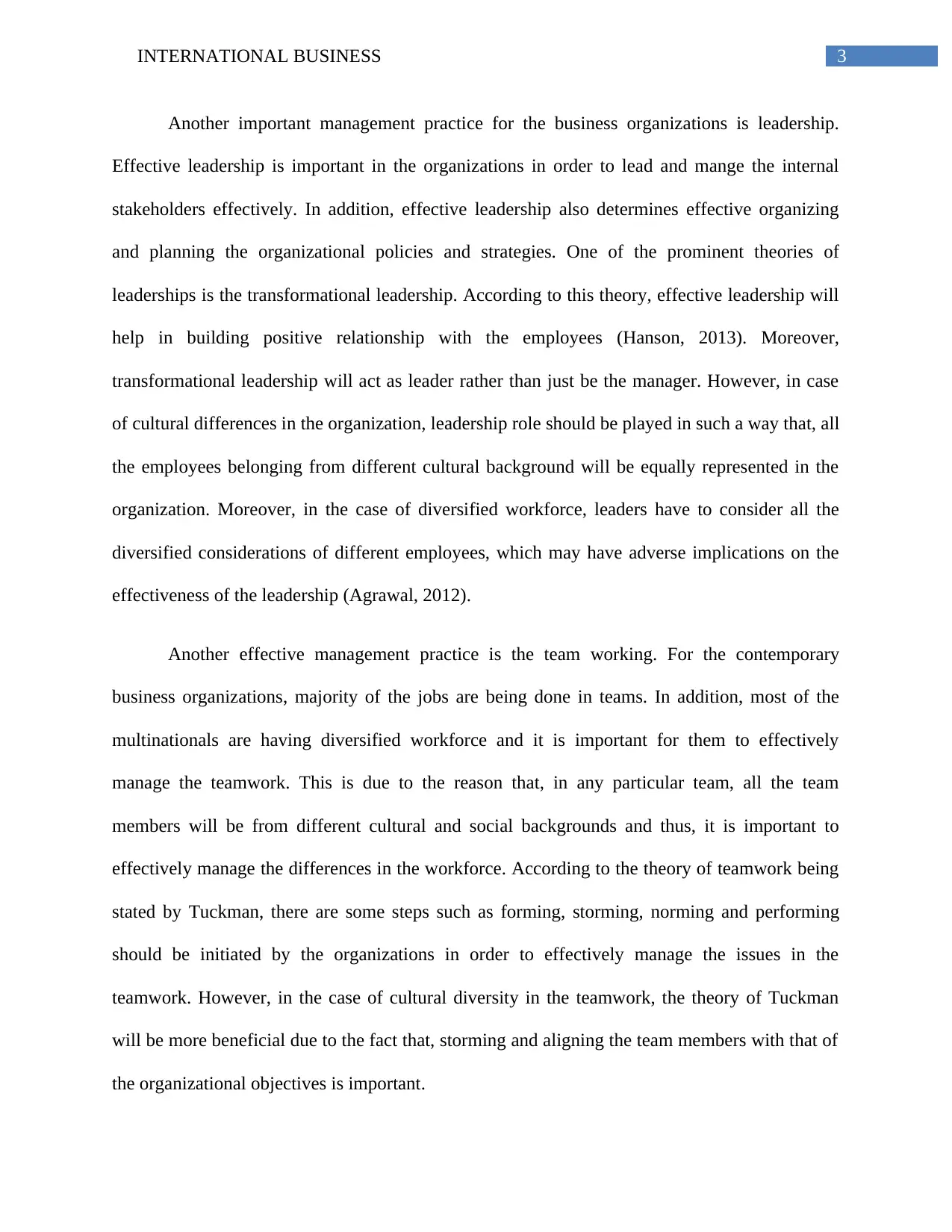
3INTERNATIONAL BUSINESS
Another important management practice for the business organizations is leadership.
Effective leadership is important in the organizations in order to lead and mange the internal
stakeholders effectively. In addition, effective leadership also determines effective organizing
and planning the organizational policies and strategies. One of the prominent theories of
leaderships is the transformational leadership. According to this theory, effective leadership will
help in building positive relationship with the employees (Hanson, 2013). Moreover,
transformational leadership will act as leader rather than just be the manager. However, in case
of cultural differences in the organization, leadership role should be played in such a way that, all
the employees belonging from different cultural background will be equally represented in the
organization. Moreover, in the case of diversified workforce, leaders have to consider all the
diversified considerations of different employees, which may have adverse implications on the
effectiveness of the leadership (Agrawal, 2012).
Another effective management practice is the team working. For the contemporary
business organizations, majority of the jobs are being done in teams. In addition, most of the
multinationals are having diversified workforce and it is important for them to effectively
manage the teamwork. This is due to the reason that, in any particular team, all the team
members will be from different cultural and social backgrounds and thus, it is important to
effectively manage the differences in the workforce. According to the theory of teamwork being
stated by Tuckman, there are some steps such as forming, storming, norming and performing
should be initiated by the organizations in order to effectively manage the issues in the
teamwork. However, in the case of cultural diversity in the teamwork, the theory of Tuckman
will be more beneficial due to the fact that, storming and aligning the team members with that of
the organizational objectives is important.
Another important management practice for the business organizations is leadership.
Effective leadership is important in the organizations in order to lead and mange the internal
stakeholders effectively. In addition, effective leadership also determines effective organizing
and planning the organizational policies and strategies. One of the prominent theories of
leaderships is the transformational leadership. According to this theory, effective leadership will
help in building positive relationship with the employees (Hanson, 2013). Moreover,
transformational leadership will act as leader rather than just be the manager. However, in case
of cultural differences in the organization, leadership role should be played in such a way that, all
the employees belonging from different cultural background will be equally represented in the
organization. Moreover, in the case of diversified workforce, leaders have to consider all the
diversified considerations of different employees, which may have adverse implications on the
effectiveness of the leadership (Agrawal, 2012).
Another effective management practice is the team working. For the contemporary
business organizations, majority of the jobs are being done in teams. In addition, most of the
multinationals are having diversified workforce and it is important for them to effectively
manage the teamwork. This is due to the reason that, in any particular team, all the team
members will be from different cultural and social backgrounds and thus, it is important to
effectively manage the differences in the workforce. According to the theory of teamwork being
stated by Tuckman, there are some steps such as forming, storming, norming and performing
should be initiated by the organizations in order to effectively manage the issues in the
teamwork. However, in the case of cultural diversity in the teamwork, the theory of Tuckman
will be more beneficial due to the fact that, storming and aligning the team members with that of
the organizational objectives is important.
Paraphrase This Document
Need a fresh take? Get an instant paraphrase of this document with our AI Paraphraser
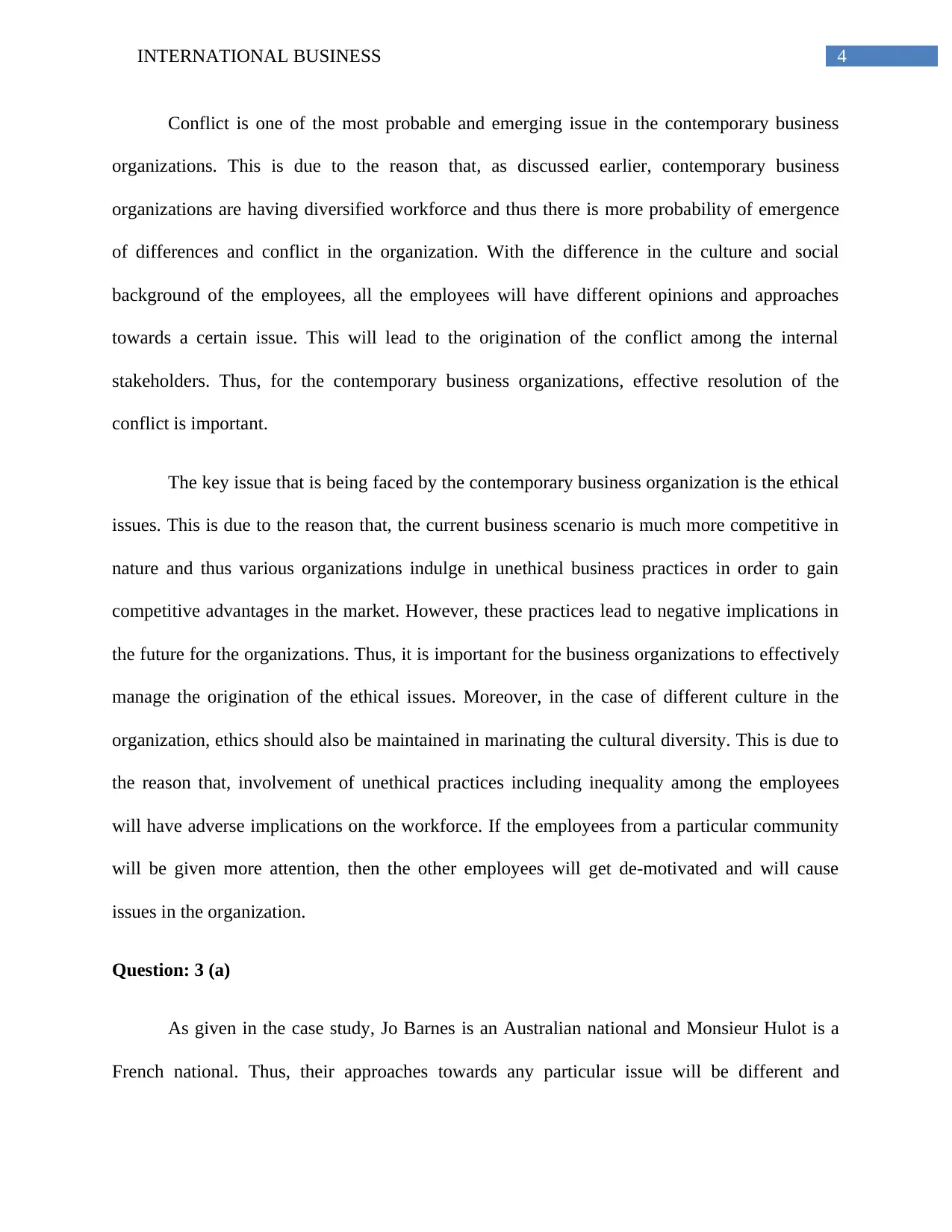
4INTERNATIONAL BUSINESS
Conflict is one of the most probable and emerging issue in the contemporary business
organizations. This is due to the reason that, as discussed earlier, contemporary business
organizations are having diversified workforce and thus there is more probability of emergence
of differences and conflict in the organization. With the difference in the culture and social
background of the employees, all the employees will have different opinions and approaches
towards a certain issue. This will lead to the origination of the conflict among the internal
stakeholders. Thus, for the contemporary business organizations, effective resolution of the
conflict is important.
The key issue that is being faced by the contemporary business organization is the ethical
issues. This is due to the reason that, the current business scenario is much more competitive in
nature and thus various organizations indulge in unethical business practices in order to gain
competitive advantages in the market. However, these practices lead to negative implications in
the future for the organizations. Thus, it is important for the business organizations to effectively
manage the origination of the ethical issues. Moreover, in the case of different culture in the
organization, ethics should also be maintained in marinating the cultural diversity. This is due to
the reason that, involvement of unethical practices including inequality among the employees
will have adverse implications on the workforce. If the employees from a particular community
will be given more attention, then the other employees will get de-motivated and will cause
issues in the organization.
Question: 3 (a)
As given in the case study, Jo Barnes is an Australian national and Monsieur Hulot is a
French national. Thus, their approaches towards any particular issue will be different and
Conflict is one of the most probable and emerging issue in the contemporary business
organizations. This is due to the reason that, as discussed earlier, contemporary business
organizations are having diversified workforce and thus there is more probability of emergence
of differences and conflict in the organization. With the difference in the culture and social
background of the employees, all the employees will have different opinions and approaches
towards a certain issue. This will lead to the origination of the conflict among the internal
stakeholders. Thus, for the contemporary business organizations, effective resolution of the
conflict is important.
The key issue that is being faced by the contemporary business organization is the ethical
issues. This is due to the reason that, the current business scenario is much more competitive in
nature and thus various organizations indulge in unethical business practices in order to gain
competitive advantages in the market. However, these practices lead to negative implications in
the future for the organizations. Thus, it is important for the business organizations to effectively
manage the origination of the ethical issues. Moreover, in the case of different culture in the
organization, ethics should also be maintained in marinating the cultural diversity. This is due to
the reason that, involvement of unethical practices including inequality among the employees
will have adverse implications on the workforce. If the employees from a particular community
will be given more attention, then the other employees will get de-motivated and will cause
issues in the organization.
Question: 3 (a)
As given in the case study, Jo Barnes is an Australian national and Monsieur Hulot is a
French national. Thus, their approaches towards any particular issue will be different and
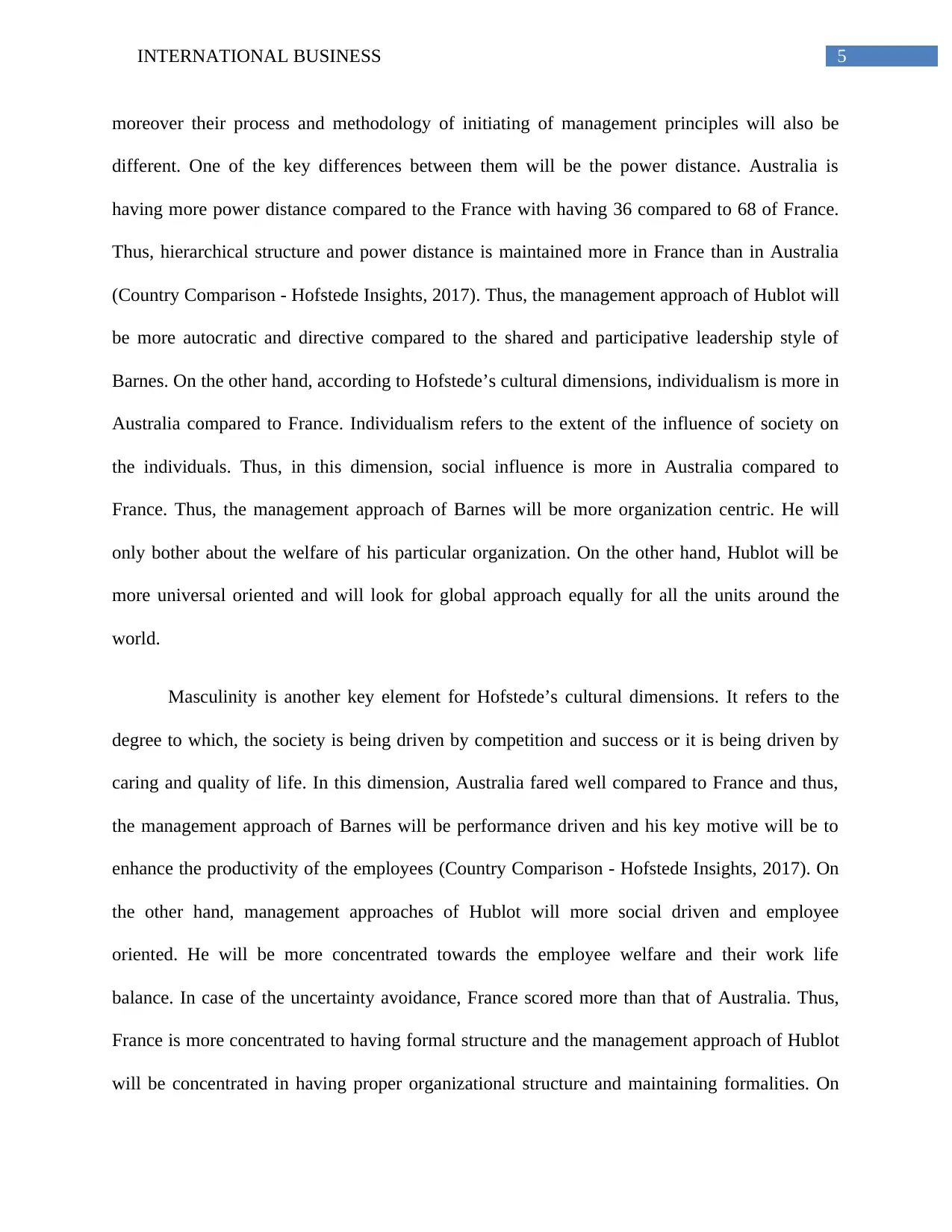
5INTERNATIONAL BUSINESS
moreover their process and methodology of initiating of management principles will also be
different. One of the key differences between them will be the power distance. Australia is
having more power distance compared to the France with having 36 compared to 68 of France.
Thus, hierarchical structure and power distance is maintained more in France than in Australia
(Country Comparison - Hofstede Insights, 2017). Thus, the management approach of Hublot will
be more autocratic and directive compared to the shared and participative leadership style of
Barnes. On the other hand, according to Hofstede’s cultural dimensions, individualism is more in
Australia compared to France. Individualism refers to the extent of the influence of society on
the individuals. Thus, in this dimension, social influence is more in Australia compared to
France. Thus, the management approach of Barnes will be more organization centric. He will
only bother about the welfare of his particular organization. On the other hand, Hublot will be
more universal oriented and will look for global approach equally for all the units around the
world.
Masculinity is another key element for Hofstede’s cultural dimensions. It refers to the
degree to which, the society is being driven by competition and success or it is being driven by
caring and quality of life. In this dimension, Australia fared well compared to France and thus,
the management approach of Barnes will be performance driven and his key motive will be to
enhance the productivity of the employees (Country Comparison - Hofstede Insights, 2017). On
the other hand, management approaches of Hublot will more social driven and employee
oriented. He will be more concentrated towards the employee welfare and their work life
balance. In case of the uncertainty avoidance, France scored more than that of Australia. Thus,
France is more concentrated to having formal structure and the management approach of Hublot
will be concentrated in having proper organizational structure and maintaining formalities. On
moreover their process and methodology of initiating of management principles will also be
different. One of the key differences between them will be the power distance. Australia is
having more power distance compared to the France with having 36 compared to 68 of France.
Thus, hierarchical structure and power distance is maintained more in France than in Australia
(Country Comparison - Hofstede Insights, 2017). Thus, the management approach of Hublot will
be more autocratic and directive compared to the shared and participative leadership style of
Barnes. On the other hand, according to Hofstede’s cultural dimensions, individualism is more in
Australia compared to France. Individualism refers to the extent of the influence of society on
the individuals. Thus, in this dimension, social influence is more in Australia compared to
France. Thus, the management approach of Barnes will be more organization centric. He will
only bother about the welfare of his particular organization. On the other hand, Hublot will be
more universal oriented and will look for global approach equally for all the units around the
world.
Masculinity is another key element for Hofstede’s cultural dimensions. It refers to the
degree to which, the society is being driven by competition and success or it is being driven by
caring and quality of life. In this dimension, Australia fared well compared to France and thus,
the management approach of Barnes will be performance driven and his key motive will be to
enhance the productivity of the employees (Country Comparison - Hofstede Insights, 2017). On
the other hand, management approaches of Hublot will more social driven and employee
oriented. He will be more concentrated towards the employee welfare and their work life
balance. In case of the uncertainty avoidance, France scored more than that of Australia. Thus,
France is more concentrated to having formal structure and the management approach of Hublot
will be concentrated in having proper organizational structure and maintaining formalities. On
⊘ This is a preview!⊘
Do you want full access?
Subscribe today to unlock all pages.

Trusted by 1+ million students worldwide
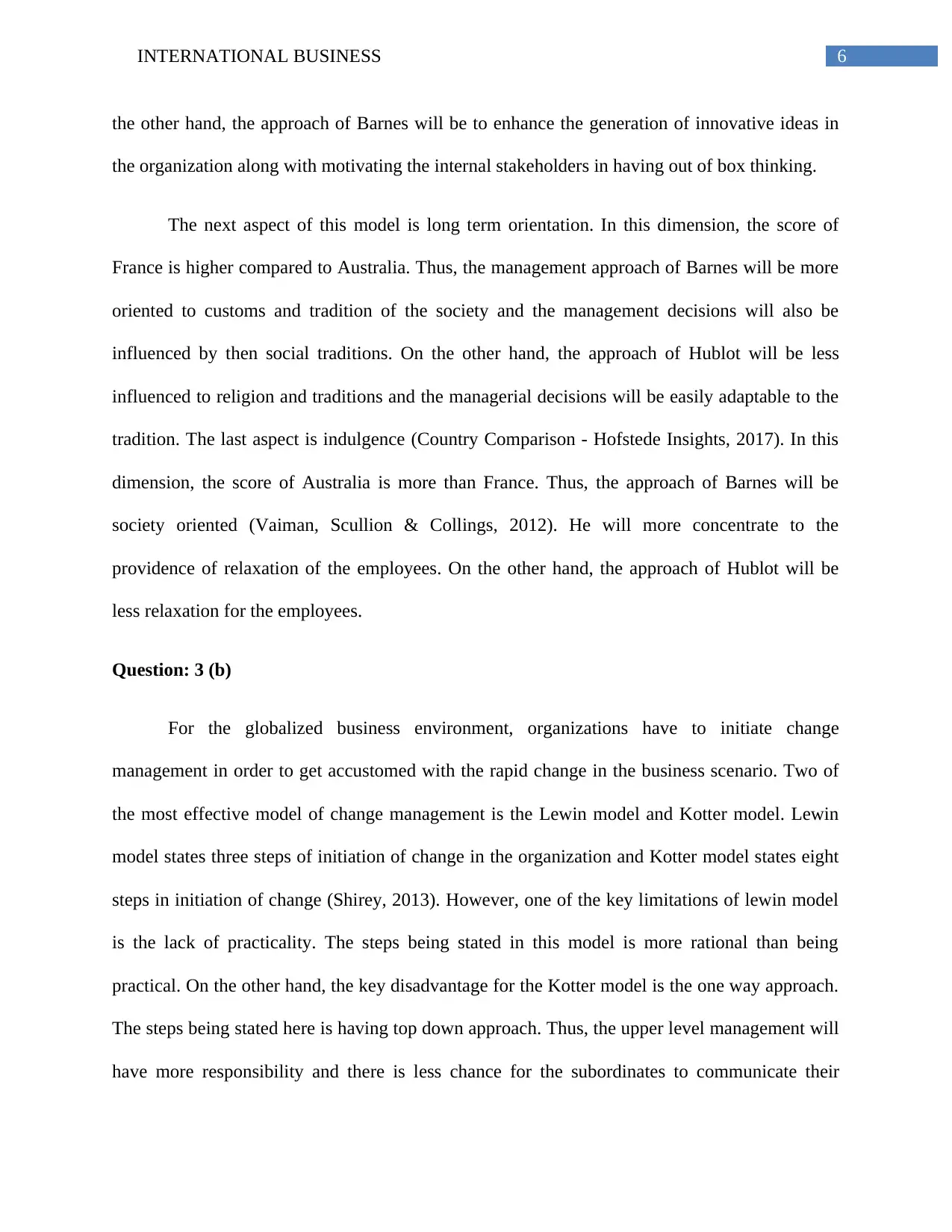
6INTERNATIONAL BUSINESS
the other hand, the approach of Barnes will be to enhance the generation of innovative ideas in
the organization along with motivating the internal stakeholders in having out of box thinking.
The next aspect of this model is long term orientation. In this dimension, the score of
France is higher compared to Australia. Thus, the management approach of Barnes will be more
oriented to customs and tradition of the society and the management decisions will also be
influenced by then social traditions. On the other hand, the approach of Hublot will be less
influenced to religion and traditions and the managerial decisions will be easily adaptable to the
tradition. The last aspect is indulgence (Country Comparison - Hofstede Insights, 2017). In this
dimension, the score of Australia is more than France. Thus, the approach of Barnes will be
society oriented (Vaiman, Scullion & Collings, 2012). He will more concentrate to the
providence of relaxation of the employees. On the other hand, the approach of Hublot will be
less relaxation for the employees.
Question: 3 (b)
For the globalized business environment, organizations have to initiate change
management in order to get accustomed with the rapid change in the business scenario. Two of
the most effective model of change management is the Lewin model and Kotter model. Lewin
model states three steps of initiation of change in the organization and Kotter model states eight
steps in initiation of change (Shirey, 2013). However, one of the key limitations of lewin model
is the lack of practicality. The steps being stated in this model is more rational than being
practical. On the other hand, the key disadvantage for the Kotter model is the one way approach.
The steps being stated here is having top down approach. Thus, the upper level management will
have more responsibility and there is less chance for the subordinates to communicate their
the other hand, the approach of Barnes will be to enhance the generation of innovative ideas in
the organization along with motivating the internal stakeholders in having out of box thinking.
The next aspect of this model is long term orientation. In this dimension, the score of
France is higher compared to Australia. Thus, the management approach of Barnes will be more
oriented to customs and tradition of the society and the management decisions will also be
influenced by then social traditions. On the other hand, the approach of Hublot will be less
influenced to religion and traditions and the managerial decisions will be easily adaptable to the
tradition. The last aspect is indulgence (Country Comparison - Hofstede Insights, 2017). In this
dimension, the score of Australia is more than France. Thus, the approach of Barnes will be
society oriented (Vaiman, Scullion & Collings, 2012). He will more concentrate to the
providence of relaxation of the employees. On the other hand, the approach of Hublot will be
less relaxation for the employees.
Question: 3 (b)
For the globalized business environment, organizations have to initiate change
management in order to get accustomed with the rapid change in the business scenario. Two of
the most effective model of change management is the Lewin model and Kotter model. Lewin
model states three steps of initiation of change in the organization and Kotter model states eight
steps in initiation of change (Shirey, 2013). However, one of the key limitations of lewin model
is the lack of practicality. The steps being stated in this model is more rational than being
practical. On the other hand, the key disadvantage for the Kotter model is the one way approach.
The steps being stated here is having top down approach. Thus, the upper level management will
have more responsibility and there is less chance for the subordinates to communicate their
Paraphrase This Document
Need a fresh take? Get an instant paraphrase of this document with our AI Paraphraser
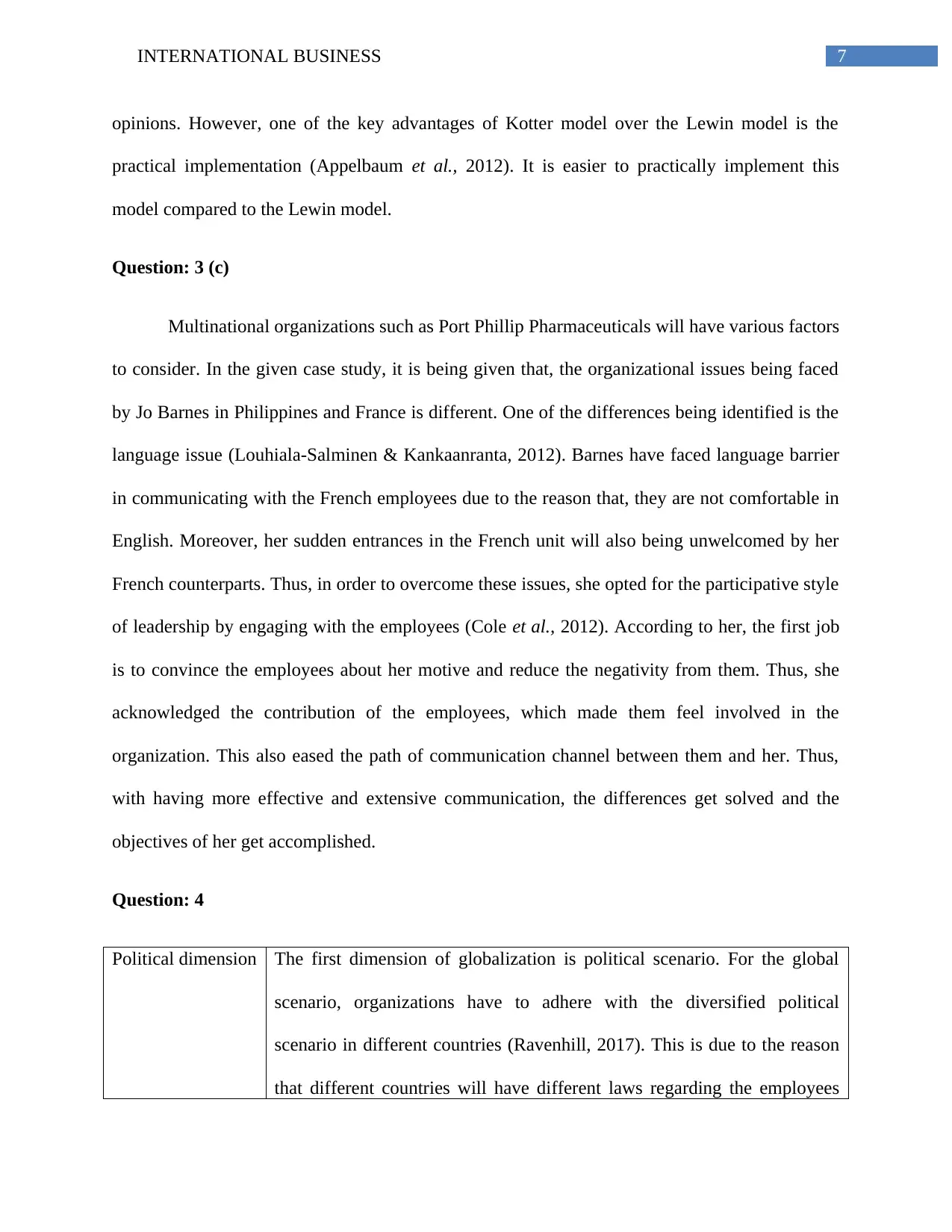
7INTERNATIONAL BUSINESS
opinions. However, one of the key advantages of Kotter model over the Lewin model is the
practical implementation (Appelbaum et al., 2012). It is easier to practically implement this
model compared to the Lewin model.
Question: 3 (c)
Multinational organizations such as Port Phillip Pharmaceuticals will have various factors
to consider. In the given case study, it is being given that, the organizational issues being faced
by Jo Barnes in Philippines and France is different. One of the differences being identified is the
language issue (Louhiala-Salminen & Kankaanranta, 2012). Barnes have faced language barrier
in communicating with the French employees due to the reason that, they are not comfortable in
English. Moreover, her sudden entrances in the French unit will also being unwelcomed by her
French counterparts. Thus, in order to overcome these issues, she opted for the participative style
of leadership by engaging with the employees (Cole et al., 2012). According to her, the first job
is to convince the employees about her motive and reduce the negativity from them. Thus, she
acknowledged the contribution of the employees, which made them feel involved in the
organization. This also eased the path of communication channel between them and her. Thus,
with having more effective and extensive communication, the differences get solved and the
objectives of her get accomplished.
Question: 4
Political dimension The first dimension of globalization is political scenario. For the global
scenario, organizations have to adhere with the diversified political
scenario in different countries (Ravenhill, 2017). This is due to the reason
that different countries will have different laws regarding the employees
opinions. However, one of the key advantages of Kotter model over the Lewin model is the
practical implementation (Appelbaum et al., 2012). It is easier to practically implement this
model compared to the Lewin model.
Question: 3 (c)
Multinational organizations such as Port Phillip Pharmaceuticals will have various factors
to consider. In the given case study, it is being given that, the organizational issues being faced
by Jo Barnes in Philippines and France is different. One of the differences being identified is the
language issue (Louhiala-Salminen & Kankaanranta, 2012). Barnes have faced language barrier
in communicating with the French employees due to the reason that, they are not comfortable in
English. Moreover, her sudden entrances in the French unit will also being unwelcomed by her
French counterparts. Thus, in order to overcome these issues, she opted for the participative style
of leadership by engaging with the employees (Cole et al., 2012). According to her, the first job
is to convince the employees about her motive and reduce the negativity from them. Thus, she
acknowledged the contribution of the employees, which made them feel involved in the
organization. This also eased the path of communication channel between them and her. Thus,
with having more effective and extensive communication, the differences get solved and the
objectives of her get accomplished.
Question: 4
Political dimension The first dimension of globalization is political scenario. For the global
scenario, organizations have to adhere with the diversified political
scenario in different countries (Ravenhill, 2017). This is due to the reason
that different countries will have different laws regarding the employees
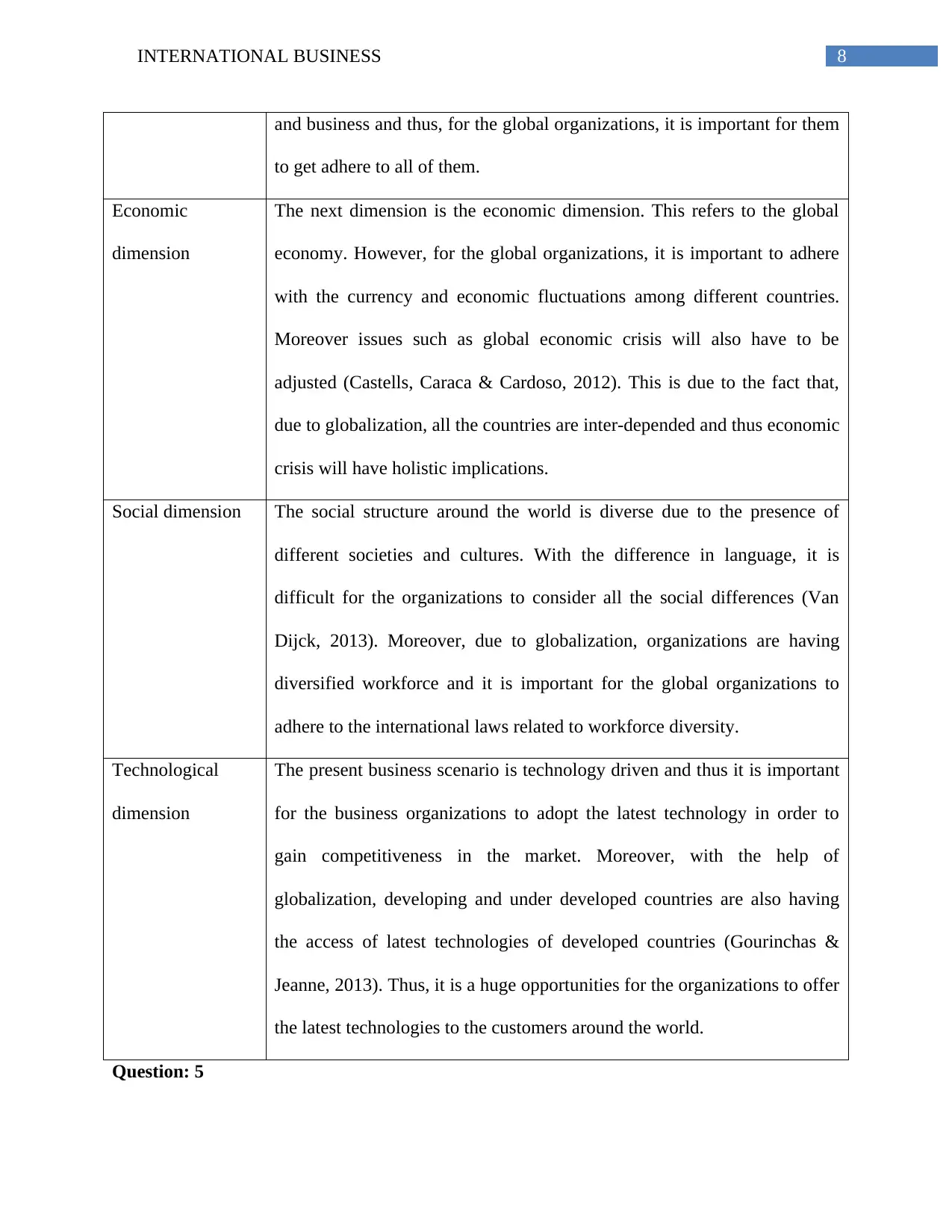
8INTERNATIONAL BUSINESS
and business and thus, for the global organizations, it is important for them
to get adhere to all of them.
Economic
dimension
The next dimension is the economic dimension. This refers to the global
economy. However, for the global organizations, it is important to adhere
with the currency and economic fluctuations among different countries.
Moreover issues such as global economic crisis will also have to be
adjusted (Castells, Caraca & Cardoso, 2012). This is due to the fact that,
due to globalization, all the countries are inter-depended and thus economic
crisis will have holistic implications.
Social dimension The social structure around the world is diverse due to the presence of
different societies and cultures. With the difference in language, it is
difficult for the organizations to consider all the social differences (Van
Dijck, 2013). Moreover, due to globalization, organizations are having
diversified workforce and it is important for the global organizations to
adhere to the international laws related to workforce diversity.
Technological
dimension
The present business scenario is technology driven and thus it is important
for the business organizations to adopt the latest technology in order to
gain competitiveness in the market. Moreover, with the help of
globalization, developing and under developed countries are also having
the access of latest technologies of developed countries (Gourinchas &
Jeanne, 2013). Thus, it is a huge opportunities for the organizations to offer
the latest technologies to the customers around the world.
Question: 5
and business and thus, for the global organizations, it is important for them
to get adhere to all of them.
Economic
dimension
The next dimension is the economic dimension. This refers to the global
economy. However, for the global organizations, it is important to adhere
with the currency and economic fluctuations among different countries.
Moreover issues such as global economic crisis will also have to be
adjusted (Castells, Caraca & Cardoso, 2012). This is due to the fact that,
due to globalization, all the countries are inter-depended and thus economic
crisis will have holistic implications.
Social dimension The social structure around the world is diverse due to the presence of
different societies and cultures. With the difference in language, it is
difficult for the organizations to consider all the social differences (Van
Dijck, 2013). Moreover, due to globalization, organizations are having
diversified workforce and it is important for the global organizations to
adhere to the international laws related to workforce diversity.
Technological
dimension
The present business scenario is technology driven and thus it is important
for the business organizations to adopt the latest technology in order to
gain competitiveness in the market. Moreover, with the help of
globalization, developing and under developed countries are also having
the access of latest technologies of developed countries (Gourinchas &
Jeanne, 2013). Thus, it is a huge opportunities for the organizations to offer
the latest technologies to the customers around the world.
Question: 5
⊘ This is a preview!⊘
Do you want full access?
Subscribe today to unlock all pages.

Trusted by 1+ million students worldwide
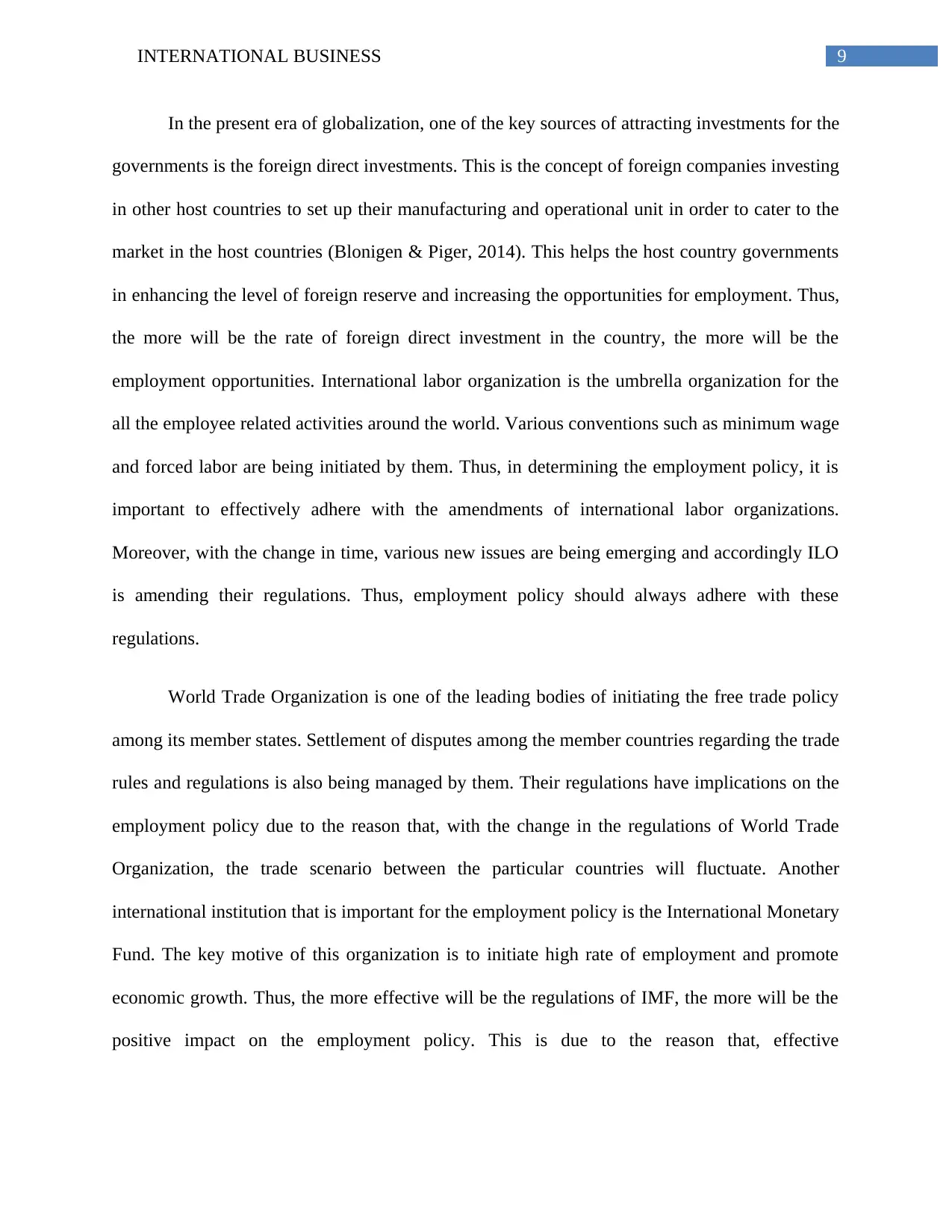
9INTERNATIONAL BUSINESS
In the present era of globalization, one of the key sources of attracting investments for the
governments is the foreign direct investments. This is the concept of foreign companies investing
in other host countries to set up their manufacturing and operational unit in order to cater to the
market in the host countries (Blonigen & Piger, 2014). This helps the host country governments
in enhancing the level of foreign reserve and increasing the opportunities for employment. Thus,
the more will be the rate of foreign direct investment in the country, the more will be the
employment opportunities. International labor organization is the umbrella organization for the
all the employee related activities around the world. Various conventions such as minimum wage
and forced labor are being initiated by them. Thus, in determining the employment policy, it is
important to effectively adhere with the amendments of international labor organizations.
Moreover, with the change in time, various new issues are being emerging and accordingly ILO
is amending their regulations. Thus, employment policy should always adhere with these
regulations.
World Trade Organization is one of the leading bodies of initiating the free trade policy
among its member states. Settlement of disputes among the member countries regarding the trade
rules and regulations is also being managed by them. Their regulations have implications on the
employment policy due to the reason that, with the change in the regulations of World Trade
Organization, the trade scenario between the particular countries will fluctuate. Another
international institution that is important for the employment policy is the International Monetary
Fund. The key motive of this organization is to initiate high rate of employment and promote
economic growth. Thus, the more effective will be the regulations of IMF, the more will be the
positive impact on the employment policy. This is due to the reason that, effective
In the present era of globalization, one of the key sources of attracting investments for the
governments is the foreign direct investments. This is the concept of foreign companies investing
in other host countries to set up their manufacturing and operational unit in order to cater to the
market in the host countries (Blonigen & Piger, 2014). This helps the host country governments
in enhancing the level of foreign reserve and increasing the opportunities for employment. Thus,
the more will be the rate of foreign direct investment in the country, the more will be the
employment opportunities. International labor organization is the umbrella organization for the
all the employee related activities around the world. Various conventions such as minimum wage
and forced labor are being initiated by them. Thus, in determining the employment policy, it is
important to effectively adhere with the amendments of international labor organizations.
Moreover, with the change in time, various new issues are being emerging and accordingly ILO
is amending their regulations. Thus, employment policy should always adhere with these
regulations.
World Trade Organization is one of the leading bodies of initiating the free trade policy
among its member states. Settlement of disputes among the member countries regarding the trade
rules and regulations is also being managed by them. Their regulations have implications on the
employment policy due to the reason that, with the change in the regulations of World Trade
Organization, the trade scenario between the particular countries will fluctuate. Another
international institution that is important for the employment policy is the International Monetary
Fund. The key motive of this organization is to initiate high rate of employment and promote
economic growth. Thus, the more effective will be the regulations of IMF, the more will be the
positive impact on the employment policy. This is due to the reason that, effective
Paraphrase This Document
Need a fresh take? Get an instant paraphrase of this document with our AI Paraphraser
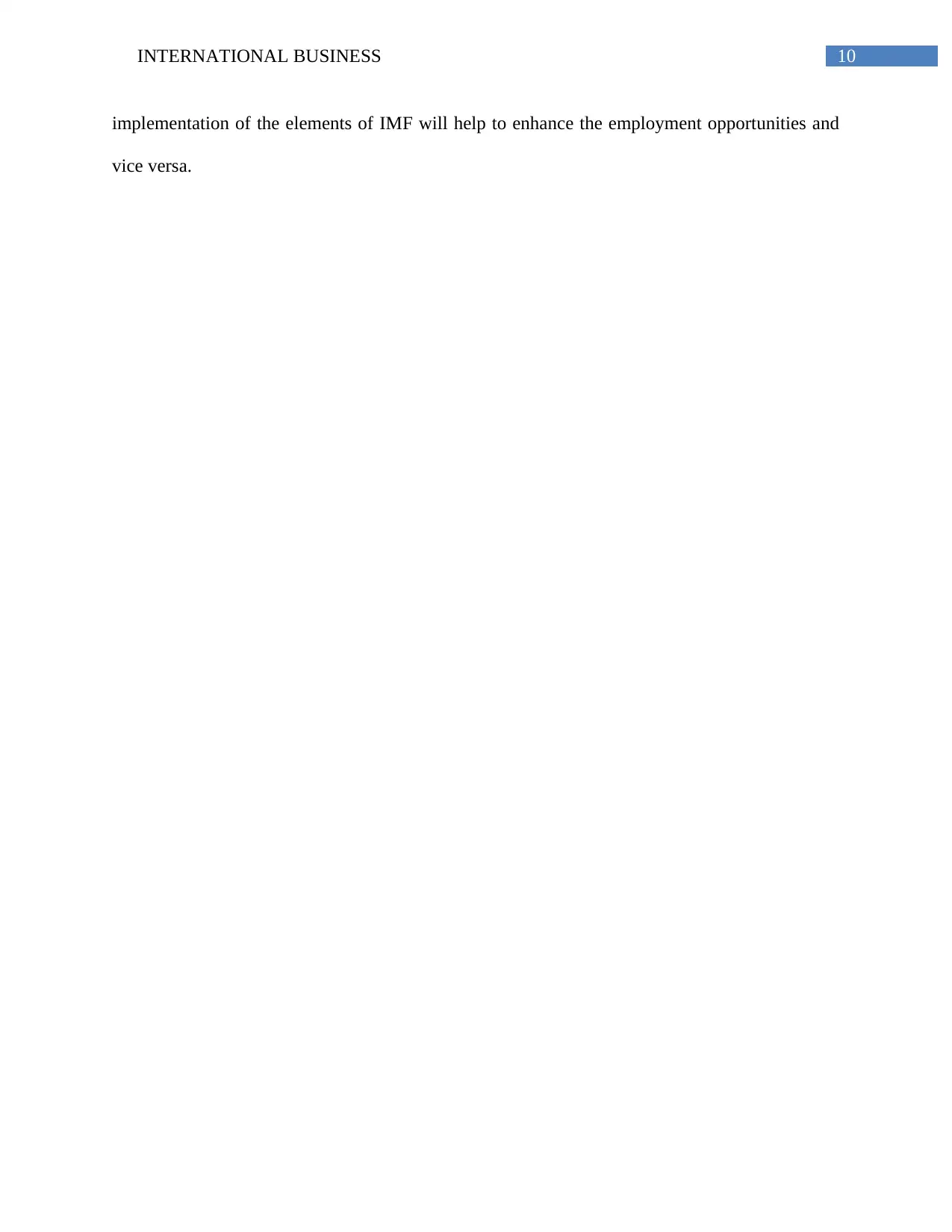
10INTERNATIONAL BUSINESS
implementation of the elements of IMF will help to enhance the employment opportunities and
vice versa.
implementation of the elements of IMF will help to enhance the employment opportunities and
vice versa.
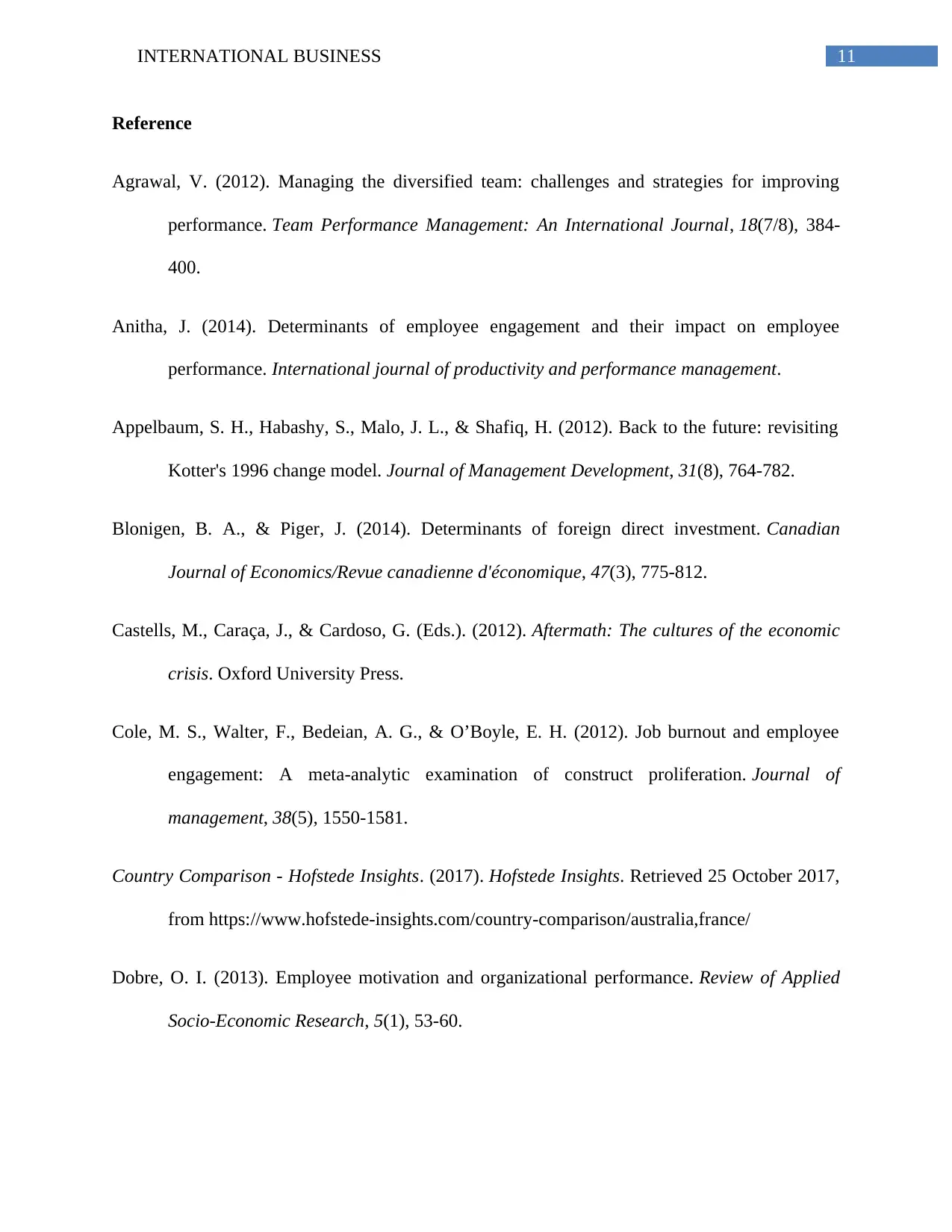
11INTERNATIONAL BUSINESS
Reference
Agrawal, V. (2012). Managing the diversified team: challenges and strategies for improving
performance. Team Performance Management: An International Journal, 18(7/8), 384-
400.
Anitha, J. (2014). Determinants of employee engagement and their impact on employee
performance. International journal of productivity and performance management.
Appelbaum, S. H., Habashy, S., Malo, J. L., & Shafiq, H. (2012). Back to the future: revisiting
Kotter's 1996 change model. Journal of Management Development, 31(8), 764-782.
Blonigen, B. A., & Piger, J. (2014). Determinants of foreign direct investment. Canadian
Journal of Economics/Revue canadienne d'économique, 47(3), 775-812.
Castells, M., Caraça, J., & Cardoso, G. (Eds.). (2012). Aftermath: The cultures of the economic
crisis. Oxford University Press.
Cole, M. S., Walter, F., Bedeian, A. G., & O’Boyle, E. H. (2012). Job burnout and employee
engagement: A meta-analytic examination of construct proliferation. Journal of
management, 38(5), 1550-1581.
Country Comparison - Hofstede Insights. (2017). Hofstede Insights. Retrieved 25 October 2017,
from https://www.hofstede-insights.com/country-comparison/australia,france/
Dobre, O. I. (2013). Employee motivation and organizational performance. Review of Applied
Socio-Economic Research, 5(1), 53-60.
Reference
Agrawal, V. (2012). Managing the diversified team: challenges and strategies for improving
performance. Team Performance Management: An International Journal, 18(7/8), 384-
400.
Anitha, J. (2014). Determinants of employee engagement and their impact on employee
performance. International journal of productivity and performance management.
Appelbaum, S. H., Habashy, S., Malo, J. L., & Shafiq, H. (2012). Back to the future: revisiting
Kotter's 1996 change model. Journal of Management Development, 31(8), 764-782.
Blonigen, B. A., & Piger, J. (2014). Determinants of foreign direct investment. Canadian
Journal of Economics/Revue canadienne d'économique, 47(3), 775-812.
Castells, M., Caraça, J., & Cardoso, G. (Eds.). (2012). Aftermath: The cultures of the economic
crisis. Oxford University Press.
Cole, M. S., Walter, F., Bedeian, A. G., & O’Boyle, E. H. (2012). Job burnout and employee
engagement: A meta-analytic examination of construct proliferation. Journal of
management, 38(5), 1550-1581.
Country Comparison - Hofstede Insights. (2017). Hofstede Insights. Retrieved 25 October 2017,
from https://www.hofstede-insights.com/country-comparison/australia,france/
Dobre, O. I. (2013). Employee motivation and organizational performance. Review of Applied
Socio-Economic Research, 5(1), 53-60.
⊘ This is a preview!⊘
Do you want full access?
Subscribe today to unlock all pages.

Trusted by 1+ million students worldwide
1 out of 13
Related Documents
Your All-in-One AI-Powered Toolkit for Academic Success.
+13062052269
info@desklib.com
Available 24*7 on WhatsApp / Email
![[object Object]](/_next/static/media/star-bottom.7253800d.svg)
Unlock your academic potential
Copyright © 2020–2025 A2Z Services. All Rights Reserved. Developed and managed by ZUCOL.





